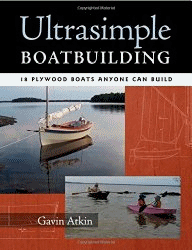Monday, March 25, 2013
Browse »
home»
Floors Glue Up & shaping sheer clamp
 One small sentence in the instructions couldn't take three days...could it?!! But yep, gluing in the floors is quite time consuming so by the time I had refined their fitting and drilled for the screws, it was quite a slow procedure.
One small sentence in the instructions couldn't take three days...could it?!! But yep, gluing in the floors is quite time consuming so by the time I had refined their fitting and drilled for the screws, it was quite a slow procedure.
Each screw needed three separate drill bits to make the pilot holes, 12mm for the counter sunk portion, 6mm for the clearance and 4mm for the pilot in the keelson - previous short cuts resulted in broken screws, swear word and general self flagellation.....
Here you can see the floors being epoxied to the hull. A large screw secures it at the trunk down into the keelson, while further smaller screws are driven up from outside the hull at the plank laps
into the floors. The "fillers" are screwed into the keelson acting as spacer between the floors. On top of this sandwich a truck cleat is secured, which makes for a tight integrated structure allowing the lead keels weight to be distributed over the hull and tying in the centre board trunk structure.
Here you can see the fillers screwed and glued into between the floors before the trunk log cleat is assembled on top. I made wood plug to fill the screw holes, which were chiseled flush before attaching the trunk log cleat.
The finished result cooking under the infrared panel to counter the unseasonable arctic weather we are experiencing.
 Meanwhile, I made up a camber template to shape the sheers and the top of the bulkhead. The camber is specified as a 2" rise over 6'.
Meanwhile, I made up a camber template to shape the sheers and the top of the bulkhead. The camber is specified as a 2" rise over 6'.
This defines the shape of the side decks and I assume will impact also on the angle of the coaming. It looks like in my exuberance to plane the sheers, I may have over flattened the starboard sheer-clamp near stations 12 and 14, so I may have to glue back in some filler wood and re-plane before fitting the side deck...should matter as no one will ever know..unless they read it here!
 I found it a good idea to mark the topside of the template as it is easy to have it the wrong side up....which might have been the reason for my flattened sheer-clamp!!
I found it a good idea to mark the topside of the template as it is easy to have it the wrong side up....which might have been the reason for my flattened sheer-clamp!!

Floors Glue Up & shaping sheer clamp
Each screw needed three separate drill bits to make the pilot holes, 12mm for the counter sunk portion, 6mm for the clearance and 4mm for the pilot in the keelson - previous short cuts resulted in broken screws, swear word and general self flagellation.....
Here you can see the floors being epoxied to the hull. A large screw secures it at the trunk down into the keelson, while further smaller screws are driven up from outside the hull at the plank laps
into the floors. The "fillers" are screwed into the keelson acting as spacer between the floors. On top of this sandwich a truck cleat is secured, which makes for a tight integrated structure allowing the lead keels weight to be distributed over the hull and tying in the centre board trunk structure.
Here you can see the fillers screwed and glued into between the floors before the trunk log cleat is assembled on top. I made wood plug to fill the screw holes, which were chiseled flush before attaching the trunk log cleat.
The finished result cooking under the infrared panel to counter the unseasonable arctic weather we are experiencing.
 Meanwhile, I made up a camber template to shape the sheers and the top of the bulkhead. The camber is specified as a 2" rise over 6'.
Meanwhile, I made up a camber template to shape the sheers and the top of the bulkhead. The camber is specified as a 2" rise over 6'. This defines the shape of the side decks and I assume will impact also on the angle of the coaming. It looks like in my exuberance to plane the sheers, I may have over flattened the starboard sheer-clamp near stations 12 and 14, so I may have to glue back in some filler wood and re-plane before fitting the side deck...should matter as no one will ever know..unless they read it here!
 I found it a good idea to mark the topside of the template as it is easy to have it the wrong side up....which might have been the reason for my flattened sheer-clamp!!
I found it a good idea to mark the topside of the template as it is easy to have it the wrong side up....which might have been the reason for my flattened sheer-clamp!!
Subscribe to:
Post Comments (Atom)






No comments:
Post a Comment